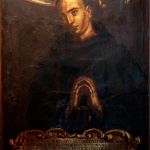Eliáš IGLÓDY was born in 1621, in Kisrorzvagy, a small village neighboring Slovenske Nove Mesto on Slovakia’s southern border with Hungary.
Childhood and Path to God
Eliáš IGLÓDY [later Štefan] was born in 1621, in Kisrorzvagy, a small village neighboring Slovenske Nove Mesto on Slovakia’s southern border with Hungary. Eliáš came from an aristocratic family and therefore received a good education. His parents were Calvinists and taught him to hate the Catholic Church.
In 1635, some apostolic missionaries came to the village. They were Conventual Franciscans sent to Hungary by the Sacred Congregation for the Propagation of the Faith in Rome. Two of the missionaries, Friars Pietro VALLONICA and Pietro CIMA, met with sixteen-year-old Eliáš. The young man soon decided to become a Catholic. He entered into the service of Count Štefan Gnári, near the village of Kisvarda and lived a good, holy life there. In the spring of 1636, he witnessed a miracle, when one of the missionaries saved the Count’s life through prayer. This event brought Count Gnári, his wife, and many servants to the Catholic faith. In 1638, Eliáš asked the Conventuals to enter the Order.
His Time with the Conventual Fraternity
Eliáš joined the fraternity at Easter time in 1638. The Minister Provincial, Friar Gianbattista Fiorentino, vested him in the habit and gave him the name Štefan. The vesting was celebrated at the friary in Rad (near Trebisov, Slovakia). The Italian missionary, Father Pietro Vallonica, was young Štefan’s spiritual director and formator. In 1638, the fraternity already had four novices and Father Pietro hoped they would become good priests one day.
The life of Brother Štefan was first published in Italy in 1711. It states that the boy’s spirit was full of joy when he entered the novitiate. His Minister Provincial wrote: “Štefan served his brothers in the spirit of love and humbleness. He was constantly and willingly practicing every spiritual exercise. Because of his knowledge of Hungarian, he was deemed the most appropriate to go begging in the countryside. Another source says that Štefan inspired the priests to preach more frequently and give lectures on spiritual themes. Štefan used to call out to poor people on the streets and the fields, inviting them to come to the friary where they could hear God’s word and find their way to the Catholic Church, as he once did.
The Martyrdom
Young Štefan’s experience in the fraternity of St. Francis lasted only six months. On Sunday, November 6, 1639, Štefan’s guardian sent him to a certain Madam Loneane, a generous patroness of the fraternity. At around three o’clock, as he was passing through the Calvinist village of Maly Hores, two men, Stefan Fesset and Michal Cose, attacked him, threw him from his horse, tied him to a tree and tried to make him reject his habit and his Catholic faith under the threat of death. When he refused, they cut a cross on his forehead with a Turkish sabre. Štefan cried out: “Jesus and Mary, help me!” He begged his attackers to let him pray. However this made them even angrier and they cut his throat.
Brother Štefan was buried on November 16, 1639 by the Most Reverend Stefan Simandi, Bishop of Transylvania, in the Provostry of Leles. With honors worthy of a martyr, they laid his body in the crypt of St. Andrew’s chapel. Štefan’s body was later transferred to the friary in Rad. During the 19th century, the friary and the church in Rad were suppressed. Nevertheless, the Conventuals never forgot Štefan. In 2011, archaeologists in Rad uncovered the old friary and found Štefan’s grave among the ruins of the church. At present, Štefan’s body is undergoing scientific investigation and current research is filling out his interesting story with new information discovered in the historical archives.
















